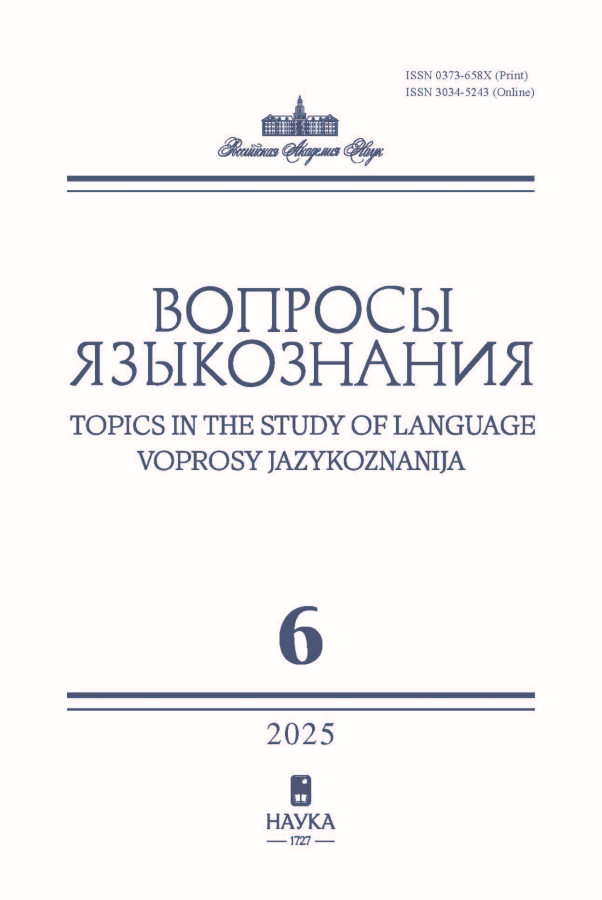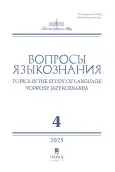Control in the infinitive purpose construction with the verbs prinesti ‘bring’ and vzjat’ ‘take’ in Russian
- Authors: Fedorov D.G1
-
Affiliations:
- HSE University
- Issue: No 4 (2025)
- Pages: 77–96
- Section: Articles
- URL: https://journals.rcsi.science/0373-658X/article/view/304105
- DOI: https://doi.org/10.31857/0373-658X.2025.4.77-96
- ID: 304105
Abstract
Keywords
References
- Байков 2020 — Байков Ф. В. Косвенный контроль в русском языке. Rhema. Рема, 2020, 1: 106–125.
- Baikov F. V. Oblique control in Russian. Rhema, 2020, 1: 106–125.
- Градинарова 2006 — Градинарова А. Русский целевой бессоюзный инфинитив: условия употребления. Болгарская русистика, 2006, 3–4: 11–20.
- Gradinarova A. Russian purpose conjunctionless infinitive: usage conditions. Bolgarskaya rusistika, 2006, 3–4: 11–20.
- Гусев 2004 — Гусев В. Ю. Целевые конструкции при глаголах движения: актанты или сирконстанты? Международный симпозиум «Типология аргументной структуры и синтаксических отношений». Тезисы докладов. Казань: КГУ, 2004, 142–144.
- Gusev V. Yu. Purpose constructions with verbs of motion: Arguments or adjuncts? Mezhdunarodnyi simpozium «Tipologiya argumentnoi struktury i sintaksicheskikh otnoshenii». Proceedings. Kazan: Kazan State Univ., 2004, 142–144.
- Козинский 1980 — Козинский И. Ш. Кореферентные связи инфинитивных оборотов в русском языке. Типология конструкций с предикатными актантами. Храковский В. С. (ред.). Л.: Наука, 1980.
- Kozinskii I. Sh. Coreference links in Russian infinitive clauses. Tipologiya konstruktsii s predikatnymi aktantami. Xhrakovskij V. S. (ed.). Leningrad: Nauka, 1980.
- Летучий 2021 — Летучий А. Б. Русский язык о ситуациях: конструкции с сентенциальными актантами. СПб.: Алетейя, 2021.
- Letuchiy A. B. Russkii yazyk o situatsiyakh: konstruktsii s sententsial’nymi aktantami [Russian language about situations: Constructions with complement clauses.St. Petersburg: Aletheia, 2021.
- Летучий, Виклова 2020 — Летучий А. Б., Виклова А. В. Подъем и смежные явления в русском языке (преимущественно на материале поведения местоимений). Вопросы языкознания, 2020, 2: 31–60.
- Letuchiy A. B., Viklova A. V. Raising and similar phenomena in Russian (mainly based on the behavior of pronouns). Voprosy Jazykoznanija, 2020, 2: 31–60.
- Лютикова 2022 — Лютикова Е. А. Есть ли синтаксический подъем в русском языке? Ч. 1. Инфинитивные клаузы. Вестник Московского университета. Серия 9. Филология, 2022, 5: 27–45.
- Lyutikova E. A. Does Russian attest syntactic raising? Part 1. Infinitival clauses. Lomonosov Philology Journal, 2022, 5: 27–45.
- НКРЯ — Национальный корпус русского языка [Russian National Corpus]. http://www.ruscorpora.ru.
- Падучева 2018 — Падучева Е. В. Инфинитив. Материалы для проекта корпусного описания русской грамматики. M., 2018. Рук.
- Paducheva E. V. Infinitive. Materialy dlya proekta korpusnogo opisaniya russkoi grammatiki. Moscow, 2018. Ms. https://rusgram.ru.
- Пекелис 2017 — Пекелис О. Е. Сентенциальные обстоятельства. Материалы для проекта корпусного описания русской грамматики. М., 2017. Рук.
- Pekelis O. E. Sentential adverbial modifiers. Materialy dlya proekta korpusnogo opisaniya russkoi grammatiki. Moscow, 2017. Ms. https://rusgram.ru.
- Стойнова 2016 — Стойнова Н. М. Контроль бессоюзного целевого инфинитива при глаголах каузации движения в русском языке: данные НКРЯ. Компьютерная лингвистика и интеллектуальные технологии: по материалам ежегодной международной конференции «Диалог», 2016, 15(22): 733–745.
- Stoinova N. M. Control of the conjunctionless purposive infinitive with verbs of caused motion in Russian: Data from RNC. Computational Linguistics and Intellectual Technologies: Papers from the Annual International Conf. “Dialogue”, 2016, 15(22): 733–745.
- Стойнова 2022 — Стойнова Н. М. «Повесь сушиться!»: вариативность в контроле инфинитива при глаголах каузации изменения позиции. Русский язык в научном освещении, 2022, 2(44): 222–241.
- Stoinova N. M. Variation in control in Russian infinitive change-of-posture constructions. Russkij jazyk v nauchnom osveshchenii, 2022, 2(44): 222–241.
- Тестелец 2001 — Тестелец Я. Г. Введение в общий синтаксис. М.: РГГУ, 2001.
- Testelets Ya. G. Vvedenie v obshchii sintaksis [Introduction to general syntax]. Moscow: Russian State Univ. for the Humanitites, 2001.
- Aikhenvald, Dixon 2005 — Aikhenvald A. Y., Dixon R. M. W. (eds.). Serial verb constructions: A crosslinguistic typology. Oxford: Oxford Univ. Press, 2005.
- Arka 2014 — Arka I. W. Double and backward control in Indonesian: An LFG analysis. Proceedings of the LFG14 Conference. Butt M., King T. H. (eds.). Stanford: CSLI Publications, 2014, 26–42.
- Bach 1982 — Bach E. Purpose clauses and control. The nature of syntactic representation. Jacobson P., Pullum G. K. (eds.). Dordrecht: Springer, 1982, 15, 35–57.
- Baker 1989 — Baker M. C. Object sharing and projection in serial verb constructions. Linguistic Inquiry, 1989, 20(4): 513–553.
- Boas 2021 — Boas H. C. Construction grammar and frame semantics. The Routledge handbook of cognitive linguistics. Xu W., Taylor J. R. (eds.). New York: Routledge, 2021, 43–77.
- Bresnan 1982 — Bresnan J. Control and complementation. Linguistic Inquiry, 1982, 13(3): 343–434.
- Broadwell 2003 — Broadwell G. A. Complex predication and parallel structures in optimality-theoretic syntax. Talk given at the 7th Workshop on Optimality Theory Syntax, Nijmegen, October 27–28, 2003.
- Bugaeva 2018 — Bugaeva A. Ainu complex predicates with reference to Japanese. Handbook of Japanese contrastive linguistics. Pardeshi P., Kageyama T. (eds.). Berlin: De Gruyter Mouton, 2018, 247–272.
- Burukina 2019 — Burukina I. Raising and control in non-finite clausal complementation. Doctoral diss. Budapest: Eötvös Loránd Univ., 2019.
- Burukina 2020 — Burukina I. Mandative verbs and deontic modals in Russian: Between obligatory control and overt embedded subjects. Glossa: a journal of general linguistics, 2020, 5: 54. 1–37.
- Chomsky 1981 — Chomsky N. Lectures on government and binding. Dordrecht: Foris, 1981.
- Cristofaro 2005 — Cristofaro S. Subordination. Oxford: Oxford Univ. Press, 2005.
- Croft 2001 — Croft W. Radical construction grammar: Syntactic theory in typological perspective. Oxford: Oxford Univ. Press, 2001.
- Culicover, Jackendoff 2001 — Culicover P. W., Jackendoff R. Control is not movement. Linguistic Inquiry, 2001, 32(3): 493–512.
- Culicover, Jackendoff 2006 — Culicover P. W., Jackendoff R. Turn over control to the semantics! Syntax, 2006, 9: 131–152.
- Farkas 1988 — Farkas D. F. On obligatory control. Linguistics and philosophy, 1988, 11: 27–58.
- Fillmore 1968 — Fillmore C. J. The case for case. Universals in linguistic theory. Bach E., Harms R. (eds.). New York: Holt, Rinehart & Winston, 1968, 1–90.
- Fillmore 2006 — Fillmore C. J. Frame Semantics. Cognitive linguistics: Basic readings. Geeraerts D. (ed.). Berlin: De Gruyter Mouton, 2006, 373–400.
- Goldberg 1995 — Goldberg A. E. Constructions: A construction grammar approach to argument structure. Chicago: The Univ. of Chicago Press, 1995.
- Goldberg 2006 — Goldberg A. E. Constructions at work: The nature of generalization in language. Oxford: Oxford Univ. Press, 2006.
- Greshler, Melnik 2017 — Greshler T. A., Melnik N. Backward control in Modern Standard Arabic. Proceedings of the 24th International Conference on Head-Driven Phrase Structure Grammar. Müller S. (ed.). Stanford: CSLI Publications, 2017, 44–60.
- Guerrero 2009 — Guerrero L. Extending the challenge of control phenomena. Proceedings of International Conference on Role and Reference Grammar (RRG 2009). Nakamura W. (ed.). 2009, 91. https://rrg.caset.buffalo.edu/rrg/ProceedingsofRRG2009_02.pdf.
- Haspelmath 2024 — Haspelmath M. Biverbal predicate constructions and related concepts: Serial verbs, converbs, auxiliaries, and grammaticalization. Ms., 2024. https://ling.auf.net/lingbuzz/008802.
- Haug 2011 — Haug D. T. T. Backward control in Ancient Greek: Subsumption or linearization? Proceedings of LFG11, 2011, 278–298.
- Holvoet 2015 — Holvoet A. Control alternations. On control properties in infinitival goal adjuncts in Baltic. Baltic Linguistics, 2015, 6: 45–77.
- Hornstein 1999 — Hornstein N. Movement and control. Linguistic inquiry, 1999, 30(1): 69–96.
- Jones 1991 — Jones C. Purpose clauses: Syntax, thematics, and semantics of English purpose constructions. Dordrecht: Springer, 1991.
- Kittilä 2005 — Kittilä S. Recipient-prominence vs. beneficiary-prominence. Linguistic Typology, 2005, 9(2): 269–297.
- Landau 2000 — Landau I. Elements of control: Structure and meaning in infinitival constructions. Dordrecht: Springer, 2000.
- Landau 2021 — Landau I. A selectional theory of adjunct control. Cambridge (MA): MIT Press, 2021.
- Lasnik 1997 — Lasnik H. Exceptional case marking: Perspectives old and new. Proceedings of Formal Approaches to Slavic Linguistics, 1997, 6: 187–211.
- Matsumoto 1996 — Matsumoto Y. Complex predicates in Japanese: A syntactic and semantic study of the notion ‘word’. Stanford: CSLI Publications, 1996
- Minor 2013 — Minor S. Controlling the hidden restrictor: A puzzle with control in Russian. Proceedings of NELS 42. Keine S., Sloggett S. (eds.). Toronto: Univ. of Toronto, 2013, 29–40.
- Mouret 2006 — Mouret F. A phrase structure approach to argument cluster coordination. The Proceedings of the 13th International Conference on Head-Driven Phrase Structure Grammar. Stanford: CSLI Publications, 2006, 247–267.
- Newman 1998 — Newman J. (ed.). The linguistics of giving. Amsterdam: John Benjamins, 1998.
- Polinsky, Potsdam 2002 — Polinsky M., Potsdam E. Backward control. Linguistic Inquiry, 2002, 33(2): 245–282.
- Postal 1974 — Postal P. M. On raising: One rule of English grammar and its theoretical implications. Cambridge: Cambridge Univ. Press, 1974.
- Potsdam 2009 — Potsdam E. Malagasy backward object control. Language, 2009, 85(4): 754–784.
- Pullum, Zwicky 1986 — Pullum G. K., Zwicky A. M. Phonological resolution of syntactic feature conflict. Language, 1986, 62(4): 751–773.
- Ross 1967 — Ross J. R. Constraints on variables in syntax. Ph.D. diss. Cambridge (MA): Massachusetts Institute of Technology, 1967.
- Rudnev Shikunova 2022 — Rudnev P., Shikunova A. Idioms, NP position: Evidence from Russian. Typology of Morphosyntactic Parameters, 2022, 5(1): 91–106.
- Schmidtke-Bode 2009 — Schmidtke-Bode K. A typology of purpose clauses. Amsterdam: John Benjamins, 2009.
- Simonin 2013 — Simonin O. Adverbial and relative to-infinitives. Journal of English Linguistics, 2013, 41(1): 4–32.
- Stiebels 2007 —Stiebels B. Towards a typology of complement control. ZAS Papers in Linguistics, 2007, 47: 1–80.
- Torrent 2009 — Torrent T. T. A Rede de Construções em Para (SN) Infinitivo: uma abordagem centrada no uso para as relações de herança e mudança construcionais. Ph.D. diss. Rio de Janeiro: Universidade Federal do Rio de Janeiro, 2009.
- Torrent 2011 — Torrent T. T. The construction network reconfiguration hypothesis. Letras & Letras, 2011, 27(1): 143–162.
- Torrent 2015 — Torrent T. T. On the relation between inheritance and change: The constructional convergence and the construction network reconfiguration hypotheses. Diachronic Construction Grammar.
- Barðdal J., Smirnova E., Sommerer L., Spike G. (eds.). Amsterdam: John Benjamins, 2015, 173–212.
- Verstraete 2008 — Verstraete J. C. The status of purpose, reason, and intended endpoint in the typology of complex sentences: Implications for layered models of clause structure. Linguistics, 2008, 46(4): 757–788.
- Williams 1980 — Williams E. Predication. Linguistic Inquiry, 1980, 11(1): 203–238.
- Willich 2022 — Willich A. Introducing Construction Semantics (CxS): A frame-semantic extension of Construction Grammar and constructicography. Linguistics Vanguard, 2022, 8(1): 139–149.
- Wurmbrand 2001 — Wurmbrand S. Infinitives: Restructuring and clause structure. Berlin: Mouton de Gruyter, 2001.










